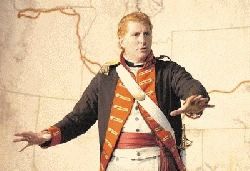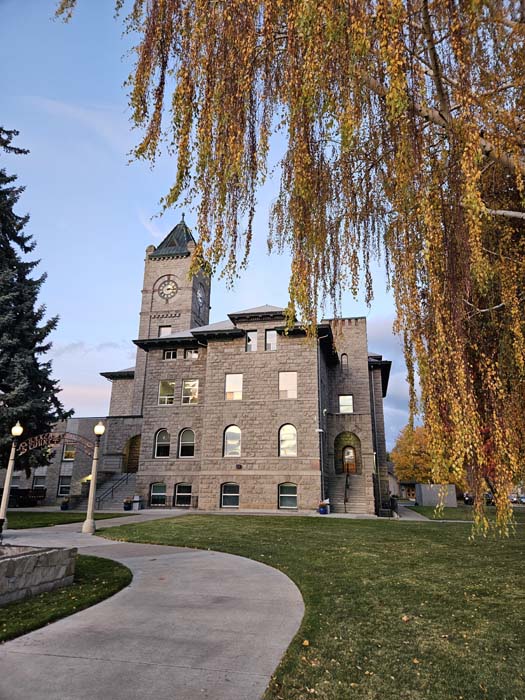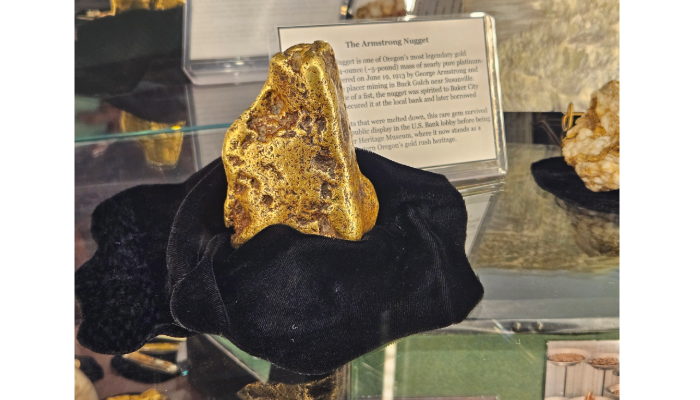Corps of Discovery: William Clark
Published 12:00 am Friday, June 2, 2006

- Craig Rockwell portrays Capt. William Clark, co-leader of the Lewis and Clark Expedition. Rockwell recently performed at the Oregon Trail Interpretive Center, where stories about the expedition, Sacagawea and little known truths kept the attention of audiences. (Baker City Herald/S. John Collins).
By LISA BRITTON
Trending
Of the Baker City Herald
Craig Rockwell hated history.
andquot;It was boring,andquot; he says.
Trending
Yet here he stands, decked out in an early 1800s military uniform with a sword secured to his belt.
You can call him Captain William Clark, as in the Lewis and Clark Expedition.
andquot;Women were not allowed in the Army what was this man thinking?andquot; he asks his audience, raising his eyebrows and shaking his red-haired head. andquot;And this woman was great with child.andquot;
But this woman, Sacagawea, was a great asset to their exploration of the west.
andquot;No civilization would take a woman into battle,andquot; he says. andquot;She became an ambassador of peace.andquot;
And on he talks, engaging his audience in laughter and wonder as he recounts the story of Lewis and Clark during a program at the Oregon Trail Interpretive Center.
He tells a story that is now 200 years old.
But Rockwell doesn’t really like dates.
andquot;History was nothing but worthless names and dates when I was in school,andquot; he says.
So he dresses up in costume and takes on the character of Clark to teach this story to school kids and groups across the country.
andquot;I want kids to be excited about history. Teaching history in a way that comes to life, with all the drama,andquot; he said.
His approach is this: He portrays the Clark from 200 years ago, yet visits with his audience with the knowledge of everything that happened between 1806 and 2006.
andquot;I can relate things that happened 200 years ago to what happened since then,andquot; he said. andquot;If they don’t see the value, they’re not interested.andquot;
From natural resources to history
Rockwell is the assistant natural resources manager for the U.S. Army Corps of Engineers in Clarkston, Wash. His involvement with the Lewis and Clark story began in 1980 when he began studying the history of the Corps of Engineers.
andquot;You can’t tell the story of America without telling the story of the Army,andquot; he said.
The Lewis and Clark Expedition fits right into that history it was a military expedition and Rockwell began telling that story as part of his interpretive programs in 1998.
andquot;After years in the natural resources world, I discovered history,andquot; he said with a laugh.
He chose Clark from the very beginning.
andquot;He was the most pivotal man in history, but no one knows that,andquot; Rockwell said. andquot;When Lewis committed suicide, Clark might as well have.andquot;
Though Lewis was the leader of the expedition, Rockwell said Clark was chosen as the co-leader for his reputation.
andquot;Clark was an amazing individual. He was a rock,andquot; he said.
Meriwether Lewis suffered from andquot;depressions of the mindandquot; (the words of President Jefferson), which Rockwell said resembles the modern diagnosis of bipolar disorder.
andquot;Meriwether Lewis knew when he was in his melancholy condition, he could count on Clark to keep things going,andquot; he said.
Rockwell became involved with the Lewis and Clark story to a greater extent when, in 1996, plans began forming for the bicentennial celebration.
He became the Columbia River Basin coordinator on the Corps of Engineers National Lewis and Clark Bicentennial Team in 1999, and in 2001 he was selected as one of two field liaisons for the Lewis and Clark Bicentennial Caucus of the U.S. Congress.
He’s been involved with a number of bicentennial events since the celebration began on Jan. 19, 2003 at Monticello.
The three-year commemoriation of the Expedition has involved local, regional and national events across the country, and the next National Signature Event will be June 5-17 in Lewiston, Idaho. It is hosted by the Nez Perce tribe.
Rockwell will be there to staff the museum tent as William Clark.
But he’ll look a little different.
You can just call him Brigadier General William Clark, a rank Clark obtained in February 1807.
The month-long celebration will include:
o Corps of Discovery II: 200 Years into the Future, June 5-17 at Lewis-Clark State College, 500 Eighth Ave.
The National Park Service Corps of Discovery II and Discovery Expo will be open daily. The central feature is the andquot;Tent of Many Voices,andquot; a 150-seat venue for cultural arts demonstrations, folklore, music, living history presentations, readings from the expedition journals and more.
andquot;We’re allowing the Lewis and Clark story to be told from whatever cultural perspective you have,andquot; Rockwell said.
o Discovery Expo, June 5-17, Lewis-Clark State College The Summer of Peace Events will include the National Park Service’s National touring Lewis and Clark exhibit titled andquot;Corps of Discovery II: 200 Years to the Future.andquot; The exhibit, developed in cooperation with Indian Tribal partners, other federal agencies, state and local entities and private non-profit groups, will set up in the Lewis-Clark State College campus.
Free programs include a colorful exhibit tent, 200-seat multimedia-ready auditorium, 2/3-scale keelboat, 28-foot dugout canoe and a 16-foot diameter Indian lodge or tipi, all staffed by interpretive specialists.
Near the Corps II exhibition are several other exhibits and programs, including two interactive programs sponsored by the Bureau of Land Management and the U.S. Fish and Wildlife service.
o Bicentennial Film Festival, June 14-17, Lewis-Clark State College Library A collection of films, most produced specifically for the Bicentennial.
o The Summer of Peace Village, June 14-17, 9 a.m. to 5 p.m. at Lewis-Clark State College Daily interpretive activities, music, story-telling, traditional art and craft demonstrations, traditional games (stick and ball games, tipi pitching, etc.), art/craft and food vendors, re-enactments, and other activities will be hosted by Nez Perce Tribal members.
For a complete schedule, visit the Web site at www.summerofpeace.org. To learn more about the Lewis and Clark Bicentennial celebration, visit www.lewisandclark200.org.









